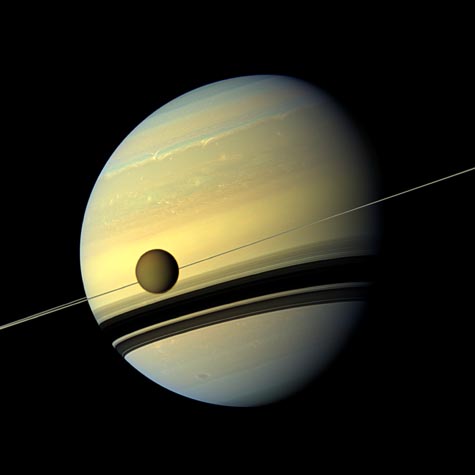
Name: Titan
Satellite of: Saturn
Mission: Cassini-Huygens
Spacecraft: Cassini Orbiter
Image Credit: NASA/JPL-Caltech/Space Science Institute
Release Date: August 29, 2012
Colorful Colossuses and Changing Hues
A giant of a moon appears before a giant of a planet undergoing seasonal changes in this natural color view of Titan and Saturn from NASA's Cassini spacecraftTitan, Saturn's largest moon, measures 3,200 miles, or 5,150 kilometers, across and is larger than the planet Mercury. Cassini scientists have been watching the moon's south pole since a vortex appeared in its atmosphere in 2012. See PIA14919 and PIA14920 to learn more about this mass of swirling gas around the pole in the atmosphere of the moon.
As the seasons have changed in the Saturnian system, and spring has come to the north and autumn to the south, the azure blue in the northern Saturnian hemisphere that greeted Cassini upon its arrival in 2004 is now fading. The southern hemisphere, in its approach to winter, is taking on a bluish hue. This change is likely due to the reduced intensity of ultraviolet light and the
Click Here
This view looks toward the northern, sunlit side of the rings from just above the ring plane.
This mosaic combines six images -- two each of red, green and blue spectral filters -- to create this natural color view. The images were obtained with the Cassini spacecraft wide-angle camera on May 6, 2012, at a distance of approximately 483,000 miles (778,000 kilometers) from Titan. Image scale is 29 miles (46 kilometers) per pixel on Titan.
The Cassini-Huygens mission is a cooperative project of NASA, the European Space Agency and the Italian Space Agency. The Jet Propulsion Laboratory, a division of the California Institute of Technology in Pasadena, manages the mission for NASA's Science Mission Directorate, Washington, D.C. The Cassini orbiter and its two onboard cameras were designed, developed and assembled at JPL. The imaging operations center is based at the Space Science Institute in Boulder, Colo.